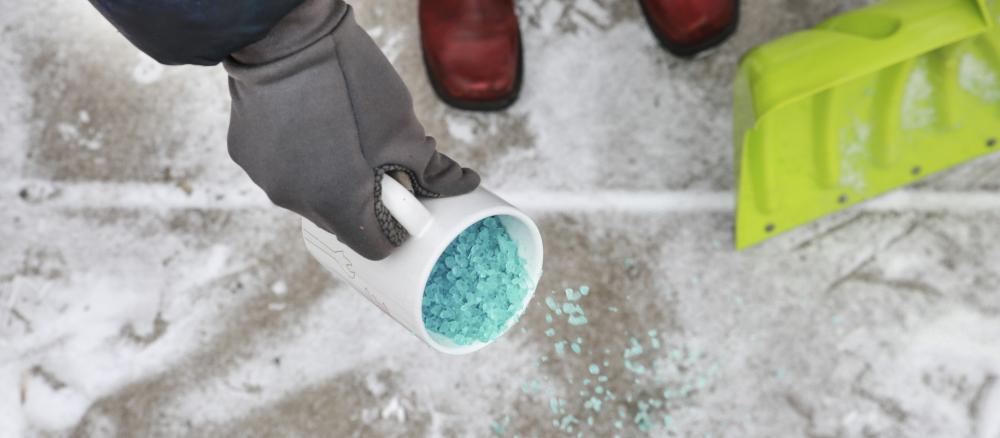Snow removal is not one-size-fits-all. You can do it better, cheaper and pollution-free.
Do you shovel your own sidewalks or hire a snow removal service? Does your business shovel snow at the entrance? Do you provide snow removal services for hire? If the answer is “yes” to any of these questions, keep reading and learn about ways to keep sidewalks, entryways, parking lots and driveways safe in winter while saving money and reducing water pollution.
Water pollution from salt (or chlorides) is widespread in the Twin Cities and the vast majority comes from deicers used in winter maintenance. As little as a single teaspoon of salt pollutes five gallons of water, the equivalent of a 50-pound bag of salt polluting 10,000 gallons of water. Salt becomes invisible shortly after it is applied because it dissolves and becomes difficult and costly to remove. This is significant because prevention is the only feasible way to protect our clean water.
A University of Minnesota study found that about 78% of salt applied in the Twin Cities for winter maintenance (more than 284,000 tons) ends up either in groundwater or local lakes and wetlands. The MPCA has found that groundwater in the state’s urban areas often exceeds the state standards for chloride contamination. Forty-seven bodies of water in Minnesota have tested above the standard for chloride, 39 of which are in the Twin Cities metro area.
Whether you do it yourself or hire a snow removal service, pollution-free winter maintenance is a skill. And it doesn’t take long to find out what you need to know.
Who are you? Do you…
- Do-it-yourself? Even sand for traction has environmental impacts. Stay on top of winter maintenance and become a neighborhood leader after watching this 15-minute video Improved Winter Maintenance: Good Choices for Clean Water.
- Hire a snow removal service? Choose one that is certified by the MPCA for Smart Salting or ask your current provider to become certified.
- Expect employees to clear snow at your place of business? Entryways are notorious for overapplication of salt, even when more isn't better. This 19-minute video was developed with the University of Minnesota especially for small sites, such as entryways, where safety really matters: Winter Maintenance for Small Sites. If possible, make this a part of staff training and orientation.
- Work for a snow removal service? Expand your skills and marketing potential by becoming certified in Smart Salting. Learn more on the Smart Salting training page.
© 2013 Mississippi Watershed Management Organization, all rights reserved. Reprinted with permission.
Tips to minimize salt use
- Shovel. The more snow and ice you remove manually, the less salt you will have to use and the more effective it can be. Whether you use a shovel, snow blower, snow plow, or ice scraper, get out there as early as you can and keep up with the storm. You may even decide that salt isn't needed.
- 15°F is too cold for salt. Most salts stop working at this temperature. Use sand instead for traction, but remember that sand does not melt ice. Use the reference table below to apply the correct product for the conditions.
- Slow down. Drive for the conditions and make sure to give plow drivers plenty of space to do their work.
- Be patient. Just because you don't see salt on the road doesn't mean it hasn't been applied. These products take time to work.
- More salt does not mean more melting. Use less than 4 pounds of salt per 1,000 square feet (an average parking space is about 150 square feet). One pound of salt is approximately a heaping 12-ounce coffee mug. Consider purchasing a hand-held spreader to help you apply a consistent amount.
- Sweep up extra. If salt or sand is visible on dry pavement it is no longer doing any work and will be washed away. Use this salt or sand somewhere else or throw it away.
- Watch a video. Improved Winter Maintenance: Good Choices for Clean Water, produced by the Mississippi River Watershed Management Organization, provides tips to homeowners about more environmentally friendly snow and ice removal.
- Share a brochure. Read and pass along Nine Mile Creek Watershed District's brochure about residential snow and ice care: Residential snow and ice care (Nine Mile Creek Watershed District)
- Check out other resources. If you are responsible for snow and ice removal somewhere other than your home, please check out our training and resources tab.
Know about the salt product
Salts can range from simple table salt to calcium chloride. Salts are used because they are able to decrease the freezing point of water. Whatever product you chose, make sure you know at what temperature it stops working. We recommend using the table below as labels may be misleading. Note that pavement temperatures are usually warmer than air temperatures. To find out the pavement temperature near you, search the Road Weather Information Service.
| Melting agent | Lowest pavement temperature at which product works |
|---|---|
| Blends | Check with manufacturer. |
| Calcium chloride (CaCl2) | -20°F |
| Calcium magnesium acetate (CMA) | 20°F |
| Magnesium chloride (MgCl2) | -10°F |
| Potassium acetate (KAc) | -15°F |
| Sand | Never melts, provides traction only. |
| Sodium chloride (NaCl) | 15°F |
Training video: Improved winter maintenance - Good choices for clean water
No salt, or very little salt, is needed if you've done a good job of snow removal. This 15-minute video offers easy tips about tools, techniques, and products that you can use to keep your driveways and sidewalks safe while protecting our waters.
